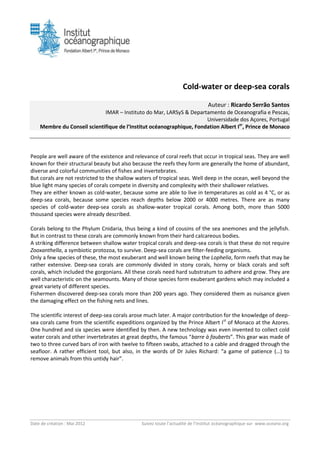
Cold-water or deep-sea corals - by Ricardo Serrao Santos
- 1. Cold-water or deep-sea corals Auteur : Ricardo Serrão Santos IMAR – Instituto do Mar, LARSyS & Departamento de Oceanografia e Pescas, Universidade dos Açores, Portugal Membre du Conseil scientifique de l’Institut océanographique, Fondation Albert Ier, Prince de Monaco People are well aware of the existence and relevance of coral reefs that occur in tropical seas. They are well known for their structural beauty but also because the reefs they form are generally the home of abundant, diverse and colorful communities of fishes and invertebrates. But corals are not restricted to the shallow waters of tropical seas. Well deep in the ocean, well beyond the blue light many species of corals compete in diversity and complexity with their shallower relatives. They are either known as cold-water, because some are able to live in temperatures as cold as 4 °C, or as deep-sea corals, because some species reach depths below 2000 or 4000 metres. There are as many species of cold-water deep-sea corals as shallow-water tropical corals. Among both, more than 5000 thousand species were already described. Corals belong to the Phylum Cnidaria, thus being a kind of cousins of the sea anemones and the jellyfish. But in contrast to these corals are commonly known from their hard calcareous bodies. A striking difference between shallow water tropical corals and deep-sea corals is that these do not require Zooxanthella, a symbiotic protozoa, to survive. Deep-sea corals are filter-feeding organisms. Only a few species of these, the most exuberant and well known being the Lophelia, form reefs that may be rather extensive. Deep-sea corals are commonly divided in stony corals, horny or black corals and soft corals, which included the gorgonians. All these corals need hard substratum to adhere and grow. They are well characteristic on the seamounts. Many of those species form exuberant gardens which may included a great variety of different species. Fishermen discovered deep-sea corals more than 200 years ago. They considered them as nuisance given the damaging effect on the fishing nets and lines. The scientific interest of deep-sea corals arose much later. A major contribution for the knowledge of deep- sea corals came from the scientific expeditions organized by the Prince Albert Ist of Monaco at the Azores. One hundred and six species were identified by then. A new technology was even invented to collect cold water corals and other invertebrates at great depths, the famous “barre à fauberts”. This gear was made of two to three curved bars of iron with twelve to fifteen swabs, attached to a cable and dragged through the seafloor. A rather efficient tool, but also, in the words of Dr Jules Richard: “a game of patience (…) to remove animals from this untidy hair”. Date de création : Mai 2012 Suivez toute l’actualité de l’Institut océanographique sur www.oceano.org
- 2. Plate 1 - Plate of drawings of two deep-water corals collected during the “Campagnes scientifiques de S.A.S le er Prince Albert I de Monaco ». The one on the right is a species of the genus Leiopathes. In this genus there are colonies that were aged more than 4000 years old. [5] Date de création : Mai 2012 Suivez toute l’actualité de l’Institut océanographique sur www.oceano.org
- 3. Plate 2 - Plate of drawings of several deep-water corals collected during the “Campagnes scientifiques de er S.A.S le Prince Albert I de Monaco”. [6] However only very recently, by the end of the XXth century and the beginning of the XXIst century, deep-sea corals received increased attention and interest from the scientific community as they have been recognized as important biodiversity hotspots in the deep-sea. The first international conference on cold- water corals happened only in the year 2000. Date de création : Mai 2012 Suivez toute l’actualité de l’Institut océanographique sur www.oceano.org
- 4. At this time the scientist had just discovered the damaging, and in many cases irreversible, effects of fisheries in deep-sea coral reefs, gorgonian gardens, stony and black corals. At the same time scientists were discovering that most of these organisms were very slow growing. One of the genus, the Leiopathes or black coral, is now considered one of the long living organism on our planet, with individuals aged 4265 years old. Recent studies on the by-catch composition of bottom fisheries revealed that Leiopathes are often damaged and captured, raising concerns on the extent of these impacts and their recovery potential. For these reasons cold water corals are nowadays protected by several conventions. Further reading: [1] Calcagno R. (2011). Les Grands Fonds Marins. Voyage dans un monde inconnu. Éditions du Rocher, Paris, France, 156 pp. [2] Carpine-Lancre J. & Saldanha L. (eds.) (1992). Dom Carlos I, Roi de Portugal, Albert Ier, Prince de Monaco: Souverains océanographes. Fondation Calouste Gulbenkian, Lisbonne, 178 pp. [3] Roark E.B., Guilderson T.P., Dunbar R.B., Fallon S.J. & Mucciarone D.A. (2009). Extreme longevity in proteinaceous deep-sea corals. PNAS, 106 (13), 5204-5208. [4] Roberts J.M., Wheeler A.J., Freiwald A., Cairns S.D. (eds.) (2009). Cold-Water Corals – The Biology and Geology of Deep-Sea Coral Habitats. Cambridge University Press, UK, xvi + 334 pp. [5] Roule L. (1905). Description des Antipathaires et Cérianthaires Recueillis par S.A.S. le Prince de Monaco dans l’Atlantique nord. Résultats des Campagnes Scientifiques Accomplies sur son Yacht par Albert Ier Prince Souverain de Monaco, fascicule XXX: 1-99, plates 1-10. [6] Studer Th. (1901). Alcyonaires provenant des campagnes de l’Hirondelle (1886-88). Résultats des Campagnes Scientifiques Accomplies sur son Yacht par Albert Ier Prince Souverain de Monaco, fascicule XX, 1-64, plates 1-11. Date de création : Mai 2012 Suivez toute l’actualité de l’Institut océanographique sur www.oceano.org
